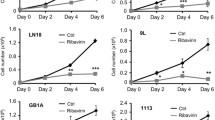Abstract
Current therapies for recurrent or progressive high-grade gliomas (HGG, WHO grade 3–4) produce a 6-month progression-free survival of only 10–25%. Migration and invasion by HGG is mediated in part by matrix metalloproteases (MMPs) which promote remodeling of the extracellular matrix. Several HIV protease inhibitors (HIVPI) decrease the expression of MMPs in astrocytes and microglia. Given these mechanisms of antitumor activity of HIVPI, we evaluated the efficacy of ritonavir/lopinavir, a combination HIVPI, in patients with progressive or recurrent HGG in an open label phase II trial. Nineteen patients were treated in this study. Patients received ritonavir/lopinavir (400 mg/100 mg) orally twice daily. All patients were treated until progression of disease or unacceptable toxicity. A complete response was seen in one patient (5%). Three patients (16%) had stable disease as the best response. Fifteen patients (79%) had progressive disease. The 6-month progression free survival (PFS6) was 11% (2 of 19 patients). Ritonavir/lopinavir was well tolerated in patients with heavily pretreated refractory HGG, and no grade 3 or 4 toxicity was seen. The activity at the dose and schedule used in this study, however, was modest and the study did not meet its efficacy endpoint.

Similar content being viewed by others
References
Stupp R, Mason WP, van den Bent MJ et al (2005) Radiotherapy plus concomitant and adjuvant temozolomide for glioblastoma. N Engl J Med 352:987–996
Friedman HS, Prados MD, Wen PY et al (2009) Bevacizumab alone and in combination with irinotecan in recurrent glioblastoma. J Clin Oncol 27:4733–4740
Wong ET, Hess KR, Gleason MJ et al (1999) Outcomes and prognostic factors in recurrent glioma patients enrolled onto phase II clinical trials. J Clin Oncol 17:2572–2578
Lamborn KR, Yung WK, Chang SM et al (2008) Progression-free survival: an important end point in evaluating therapy for recurrent high-grade gliomas. Neuro Oncol 10:162–170
Burger PC, Dubois PJ, Schold SC Jr et al (1983) Computerized tomographic and pathologic studies of the untreated, quiescent, and recurrent glioblastoma multiforme. J Neurosurg 58:159–169
Bussemakers MJ, Schalken JA (1996) The role of cell adhesion molecules and proteases in tumor invasion and metastasis. World J Urol 14:151–156
Walker DG, Lavin MF (1997) The molecular genetics of astrocytomas: current understanding and future applications. J Clin Neurosci 4:114–121
Anderson JC, McFarland BC, Gladson CL (2008) New molecular targets in angiogenic vessels of glioblastoma tumours. Expert Rev Mol Med 10:e23
Du R, Petritsch C, Lu K et al (2008) Matrix metalloproteinase-2 regulates vascular patterning and growth affecting tumor cell survival and invasion in GBM. Neuro Oncol 10:254–264
Liuzzi GM, Mastroianni CM, Latronico T et al (2004) Anti-HIV drugs decrease the expression of matrix metalloproteinases in astrocytes and microglia. Brain 127:398–407
Sgadari C, Barillari G, Toschi E et al (2002) HIV protease inhibitors are potent anti-angiogenic molecules and promote regression of Kaposi sarcoma. Nat Med 8:225–232
Gaedicke S, Firat-Geier E, Constantiniu O et al (2002) Antitumor effect of the human immunodeficiency virus protease inhibitor ritonavir: induction of tumor-cell apoptosis associated with perturbation of proteasomal proteolysis. Cancer Res 62:6901–6908
Pajonk F, Himmelsbach J, Riess K, Sommer A, McBride WH (2002) The human immunodeficiency virus (HIV)-1 protease inhibitor saquinavir inhibits proteasome function and causes apoptosis and radiosensitization in non-HIV-associated human cancer cells. Cancer Res 62:5230–5235
Pore N, Gupta AK, Cerniglia GJ, Maity A (2006) HIV protease inhibitors decrease VEGF/HIF-1alpha expression and angiogenesis in glioblastoma cells. Neoplasia 8:889–895
Gupta AK, Cerniglia GJ, Mick R, McKenna WG, Muschel RJ (2005) HIV protease inhibitors block Akt signaling and radiosensitize tumor cells both in vitro and in vivo. Cancer Res 65:8256–8265
Pati S, Pelser CB, Dufraine J et al (2002) Antitumorigenic effects of HIV protease inhibitor ritonavir: inhibition of Kaposi sarcoma. Blood 99:3771–3779
Macdonald D, Cascino T, Schold SJ et al (1990) Response criteria for phase II studies of supratentorial malignant glioma. J Clin Oncol 8:1277–1280
http://www.rxabbott.com/pdf/kaletratabpi.pdf (Accessed 3/4/2010)
van Waterschott RA, ter Heine R, Wagenaar E et al (2010) Effects of cytochrome P450 3A (CYP3A) and the drug transporters P-glycoprotein (MDR1/ABCB1) and MRP2 (ABCC2) on the pharmacokinetics of lopinavir. Br J Pharmacol 160(5):1224–1233
Cvetkovic RS, Goa KL (2003) Lopinavir/ritonavir: a review of its use in the management of HIV infection. Drugs 63(8):769–802
Kumar GN, Jayanti VK, Johnson MK et al (2004) Metabolism and disposition of the HIV-1 protease inhibitor lopinavir (ABT-378) given in combination with ritonavir in rats, dogs, and humans. Pharm Res 21(9):1622–1630
Letendre SL, van den Brande G, Hermes A et al. and the HIV Neurobehavioral Research Center Group (2007) Lopinavir with tironavir reduces the HIV RNA level in cerebrospinal fluid. Clin Infect Dis 45(11):1511–1517
Acknowledgments
The research was supported by Abbott Laboratories.
Author information
Authors and Affiliations
Corresponding author
Rights and permissions
About this article
Cite this article
Ahluwalia, M.S., Patton, C., Stevens, G. et al. Phase II trial of ritonavir/lopinavir in patients with progressive or recurrent high-grade gliomas. J Neurooncol 102, 317–321 (2011). https://doi.org/10.1007/s11060-010-0325-3
Received:
Accepted:
Published:
Issue Date:
DOI: https://doi.org/10.1007/s11060-010-0325-3




